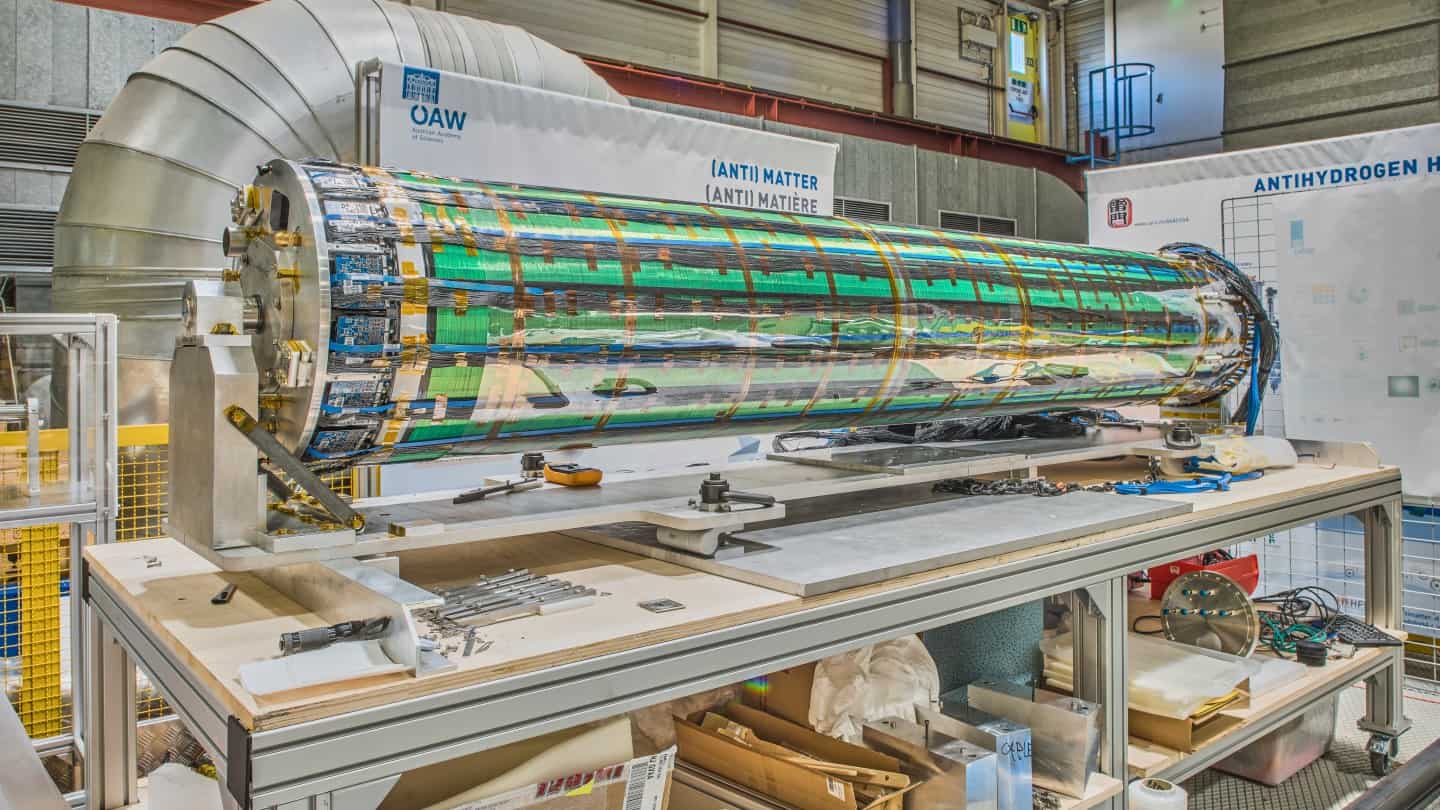
Antimatter does not “fall up”, but rather responds to the gravitational pull of the Earth in much the same way as normal matter. That is the conclusion of physicists working on the ALPHA-g experiment at CERN, who have made the first direct observation of free-falling antimatter atoms.
The experiment helps rule out the idea that a difference in their responses to gravity is somehow responsible for the fact that there is much more matter than antimatter in the visible universe. However, the measurement still leaves open the tantalizing, but very unlikely, possibility that antimatter and matter react slightly differently to gravity.
Antimatter was first predicted in 1928 and four years later the first antimatter particles – anti-electrons, or positrons – were observed in the lab. Antimatter particles appear to be identical to their matter counterparts, but with their charge, parity and time reversed. So far, studies of antiparticles suggest that they have the same masses as their counterparts and that they respond to gravity in the same way.
Banished from sight
This similarity suggests that antimatter should have been produced in the same quantity as matter during the Big Bang. This flies in the face of what we know about the visible universe, which appears to contain much more matter than antimatter. As a result, physicists are searching for subtle ways that antimatter differs from matter, because finding such differences could help explain why matter dominates over antimatter.
Indirect measurements of the effect of gravity on antimatter suggest that matter and antimatter both respond in the same way to gravity. However, the difficulties of working with antimatter meant that a direct observation of antimatter falling freely under Earth’s gravity had not been made.
While antimatter can be made in a the lab, it will annihilate upon contact with matter in an experimental apparatus. So great care must be taken to accumulate enough antimatter to do an experiment. Over the past decade, the ALPHA team at CERN have perfected the magnetic trapping of antimatter under high vacuum to minimize annihilation. Now, they have created a trap within a tall cylindrical vacuum chamber called ALPHA-g, which allows them to observe whether antimatter falls downwards or upwards.
Their experiment involves filling the chamber with antihydrogen atoms – which each comprise an antiproton and a positron. The positrons are collected from a radioactive source and the antiprotons are created by firing protons at a solid target. Both types of antiparticle are very carefully slowed down and then combined to create antihydrogen.
Escaping the trap
The ALPHA-g experiment begins with the antihydrogen magnetically trapped in the centre of the cylinder. Then the trapping field is dialled down, so that antiatoms began to escape the trap. These escapees strike the walls of the chamber, where annihilation creates a flash of light within a scintillation detector. The team observed about 80% of the annihilations below the centre of the trap, suggesting that the antiatoms fall under gravity once released from the trap. This was confirmed by repeating the experiment more than a dozen times. The team did not observe 100% of the antiatoms moving downwards because the thermal motion of the particles sent some of them upwards and they annihilated before they could fall back again – explains the ALPHA-g spokesperson Jeffrey Hangst, who is at Denmark’s Aarhus University. Hangst told Physics World that the experiment is consistent is with antihydrogen falling down.

ALPHA weighs in on antimatter
However, ALPHA-g found that the antiatoms experienced an acceleration due to Earth’s gravity that is about 0.75 of that experienced by normal matter. While this measurement has a low statistical significance, it offers tantalizing hope that physicists could soon discover a difference between matter and antimatter that could point towards new physics beyond the Standard Model.
Graham Shore of the UK’s University of Swansea tells Physics World that the ALPHA-g result should not be interpreted as evidence that antimatter responds differently than matter in Earth’s gravitational field.
“Any measurement of [a discrepancy] would be enormously unexpected and would probably indicate a new type of gravitational strength force, perhaps a graviphoton, but it is difficult to see how this could have remained hidden from precision gravitational experiments on matter,” explains Shore, who was not involved with the ALPHA-g experiment.
However, we will have to wait for more data from the experiment because the ALPHA-g has been dismantled and a spectroscopy experiment has been put in its place at CERN. Hangst and his colleagues are currently fixing a known design flaw in a magnet in ALPHA-g and working out how they can laser cool the antihydrogen atoms to improve the performance of the experiment.
The research is described in Nature.
